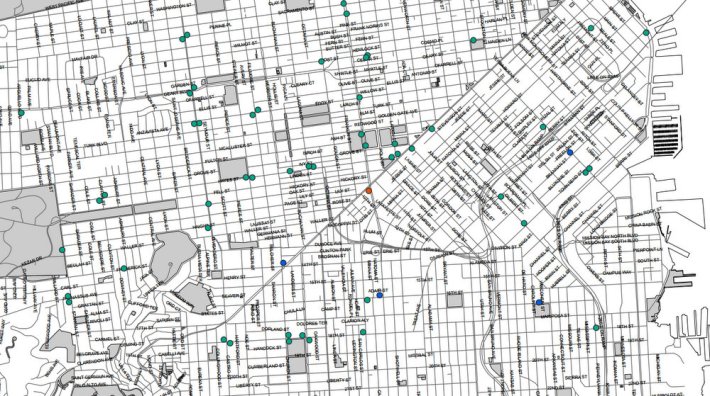
The SFMTA has released a proposed map of Muni stops where commuter shuttles would be permitted to load passengers, part of the agency's 18-month pilot program to test private-bus regulation. Shuttles currently use many of these stops, and the resulting conflicts between shuttles and Muni buses has led to transit delays. SFMTA says it hopes to reduce bus conflicts by replacing car parking with new loading zones, marked with white curbs, where shuttles can load passengers out of Muni's way.
With the vast majority of SF's curb space devoted to storing private automobiles, hiving off a sliver of that space to make room for both public and private transit to co-exist shouldn't make a huge difference. But, of the roughly 80 shared stops proposed on the map, just nine have white zones. Four of those would ban parking during morning peak hours, and five would during both morning and evening peak hours. A handful of bus stop zones would also be extended.
Are nine new white zones enough to minimize conflicts between Muni and shuttles? Transit advocates are still assessing that answer -- but it's not a simple one, since there isn't hard data on how much shuttles delay Muni, or where it happens most often.
For many of the stops, it could be that there aren't enough conflicts to warrant a white zone. As shown in a three-hour time lapse video of the shared stop outside the home of transportation planner Paul Supawanich, most of the 36 shuttle buses that arrived within that period didn't block a Muni bus.
"I hope that it was based on metrics, and wasn't a politically arrived-at figure," said Tom Radulovich, executive director of Livable City. While shuttles take cars off the road by providing convenient alternatives to driving, "The benefit of that is diminished if they're also delaying Muni. If we're going to have the shuttles using [bus] stops, it's gotta be in such away that they're creating no delay for public transit. And that's not what's happening now. I think we could get there, but little has been asked of the shuttle operators."
The SFMTA's pilot program will charge shuttle operators $1 per use of each stop, a sum that the SFMTA estimates will cover the costs of running the program. The SFMTA is prevented by law from charging more than demonstrable costs, but anti-gentrification protesters have called for higher fees, as they blame tech shuttles for high rents. The SFMTA says that the implementation of the pilot program will include serious enforcement of the new regulations, including fining shuttle operators who use stops that aren't permitted.
As we've written, tech workers who drive to work don't face the same sort of backlash faced by tech workers who take shuttles, even though car owners occupy far more curb space and contribute just as much to driving up rents. Protests targeting those who take shuttles to work in Silicon Valley distract from the deeper issues: A cycle of sprawl and gentrification, both forces that reinforce one other as cities up and down the Peninsula fail to build enough housing for their burgeoning workforces.
"The tough issues -- the questions about gentrification, property values, the nature of the city, and class divides -- don't have an easy transportation management solution," said Radulovich. "The transportation issues do."
The list of stop changes can be viewed on the agenda [PDF] for an SFMTA engineering hearing scheduled for Friday, June 20. After that, they're expected to be passed along to the SFMTA Board of Directors for final approval of the pilot.




